Home -> Motorcycle Safety Tip -> Weather
Weather - Dealing with the Elements
Weather - It's such a nice word, but mention "rain, wind, sleet or snow" to a motorcyclist, and you'll probably hear a story or two. Unfortunately, as a motorcycle rider, you need to deal with all kinds of conditions, the good, bad, and the ugly.It's a good idea to check out the weather in advance if you are traveling to a different country, or a different state. Know when the rainy season is - figure out the elevations of any mountain ranges. Very importantly, you need to know if you are going to be traveling through mountainous areas when some of the passes or roads might not yet be open. Bad weather can absolutely ruin a motorcycle trip, especially if you are planning a nice long weekend. Four days straight of torrential downpours is not fun.
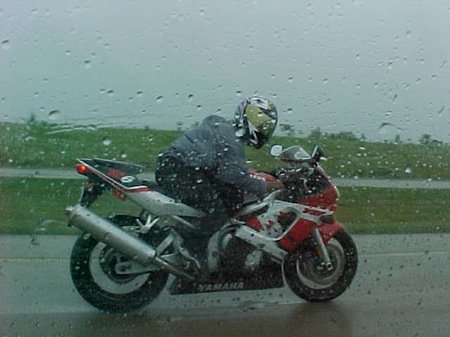
There are some types of weather that you probably just should not ride through - sleet, for example. Dense Fog is another big danger, but one that you cannot always avoid.My First Tip: Plan ahead. Research the area or region where you will be traveling. Talk to people who have been there at the time of year of your trip. Visit the Weather Channel every morning and try to figure out trends. Then, be prepared for what you anticipate the weather will be. No matter what - don't leave your raingear at home. If you do, it will rain for sure. (This I know from personal experience - TRUST me.)
Rain
Rain - No Big Deal, Right? Wrong!
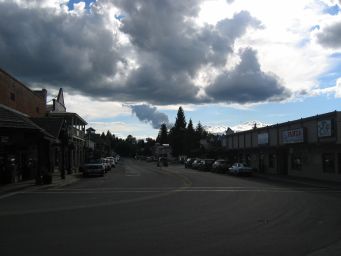
Rain can pose all types of dangers to motorcyclists - here's a few that come to mind:* Rain can be blinding - either by fogging up your visor, or just by intensity. * Rain means that motorcycles are less visible to other vehicles, especially on the highways. * Wet roads can be deceivingly slippery - watch the middle of the road where the oil collects. * Riding for hours in steady rain is tiring. * Rain with lightening is dangerous - pull off the road if you see repeated lightening strikes. * Extremely wet conditions can be particularly challenging for some motorcycles, mechanically (can you say Ducati?) Even with the right rain gear, fog-proofed visor and dry feet, riding in rain can be challenging - and it's not much fun. If you have a schedule to keep, take a deep breath and plow through it, but keep in mind that you need to be more alert than you would need to be in clear weather. Make sure that the other vehicles around you know that you are there. Be careful, and get to your destination safely.
Sleet and Snow
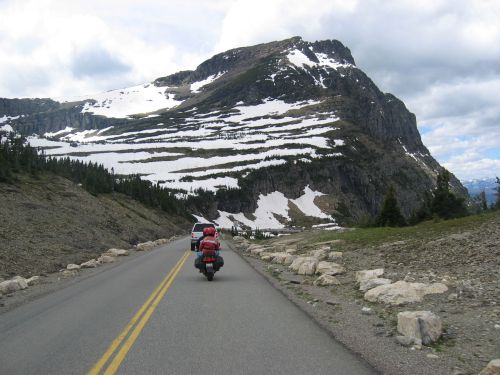
Oh, how I wish I could claim ignorance of riding my motorcycle in sleet and snow. Both are completely un-fun.Sleet is just dangerous. Cold freezing rain and motorcycles do not mix. If at all possible, avoid riding in sleet. Just pull over, grab some coffee and wait for it to pass. Motorcycle tires just don't have enough tread to manage safely in icy conditions. Snow - if deep enough, is also just dangerous. Freshly falling snow is pretty, and if it's warm enough outside, not really much different than riding in the rain. Hopefully you knew that snow was a possibility, and are dressed warmly and in waterproof outerwear.
Heated Gloves, Liners and Perhaps a Heated Jacket Would Be Even Better
If the snow gets to a point where you can't really control the motorcycle, it's time to find a place to stop.Snow on the side of the road - pretty, and usual for the Alps, and Northern Idaho - even in the summer. If you know you are going to be in higher elevations, take extra layers and put them on before you head up.
FOG - The Worst of All
The idea of riding my motorcycle again in foggy conditions makes me tremble. Yeah, not very biker-like of me to say tremble, that is exactly how I feel about fog.My absolute-number-one-most-terrifying-moment on my motorcycle was riding my first alpine mountain pass at high elevation, and almost a 45 degree road elevation in complete, blinding, fog. In dense fog, a motorcycle is invisible - freaking invisible. Not only can you not see in front of you, you are not seen by those in front of you, and behind you.
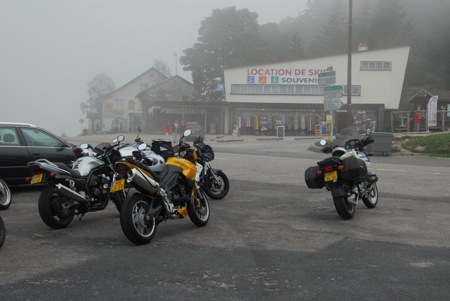
If you can find a safe place to pull off a foggy road, do it. If not, use the side of the road to guide your way. Drive slowly. If your motorcycle has blinkers, turn them on. Use your high beam headlight. Deep breathe. Take your time. A prayer wouldn't hurt, either.
Hail and Extreme Heat
If you've ever ridden through hail, you remember it. Even with protective outerwear, it hurts. And, you never forget the sound of the hail pellets hitting your helmet, windscreen and motorcycle body parts. If it didn't hurt so much, it would be somewhat funny.My advice for hail: Pull over and seek some shelter. It never hails for very long, so you aren't going to lose too much time. Extreme heat can be unbearable, unless you're moving and not forced to stop and go in traffic. Even if you are moving, on a very hot day, you need to make sure that you stay hydrated. You may not feel thirsty, but chances are, your body is losing more fluid than you know. On extremely hot days, a hydration backpack is a really great idea. Keep the fluid going in, and drink more when you stop for potty breaks.
Wind

Wind can also be problematic while riding a motorcycle. The wind may be so strong that you feel as if you are going to be blown right off the road. Unless the wind is strong enough to generate a tornado, chances are - you're going to stay on the road.What you can do to improve your "footing" is try to become "one" with the bike. Lower your head below your windscreen, pull in your knees, and try to become as aerodynamic as you can. Just ride through the wind - don't panic if the bike moves a bit with the gusts - just don't over-react. Remember, you are on a motorcycle with a bit of weight. Even the lightest sport bike, weighs over 500 pounds with a rider. You are not going to blow away, even though it may seem like it. The Bottom Line: With any extreme weather, you need to assess whether you can safely stop until the situation resolves, and if the situation can resolve. In the case of dense fog, especially in the mountains, you may have no choice but to push on to the summit. With snow, you may be forced to find a place to stop if the snow becomes too deep to maneuver. In my opinion, sleet is always dangerous, as is an ice storm. Wind and rain, short of a tornado, can be dealt with, with calmness, skill and attention. And, hopefully...better weather ahead: The sun will come out tomorrow.
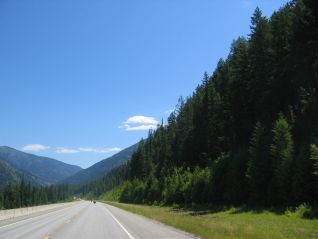
|












